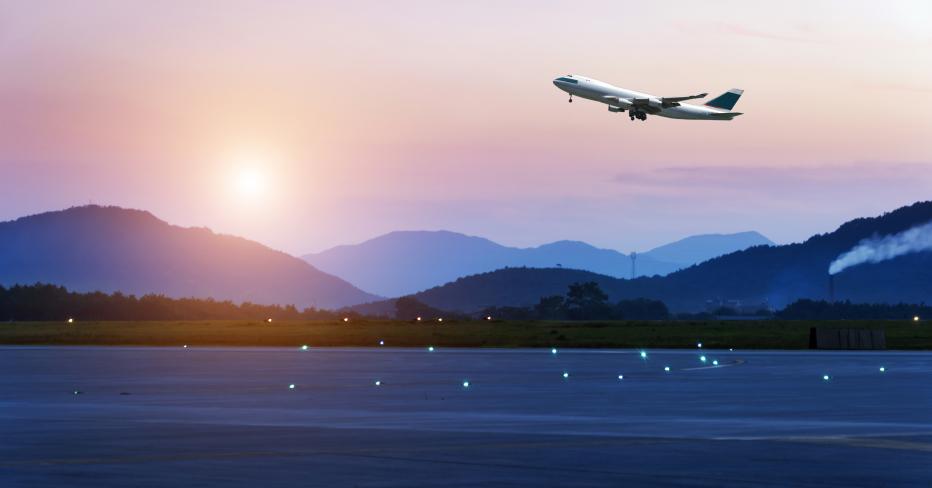
It comes as no surprise that aviation has long benefitted from ideas, innovations and solutions borne out of other industries. It’s worth recalling that, when the era of mass air travel began some 50 years ago, the concept of conveyor systems was first introduced to tackle the logistics of manual luggage handling as aircrafts grew larger in size. The idea was pioneered by miners in 1900s and was progressively developed by the manufacturing industry. Similar can be said for airport security screening, which was formerly directed at aircraft hijacking prevention in the U.S. circa 1973. Walk-through metal detector gates were first utilized in maximum-security facilities while x-ray technology was first introduced by medical science. Finally, an example borne from the retail sector would be the concept of duty-free shopping. First introduced at Shannon Airport in Ireland in 1947, the retail scheme was first established post World War II, to capitalize on the growth in international travel while incentivizing spending at airports. Essentially, this was an innovation aimed at boosting airport revenue and they haven’t looked back since!
Why does this matter? We believe that now more than ever, further lessons can be drawn from other sectors as airports plan their recovery. From healthcare, retail, transportation and smart cities, we explored the broader perspective of urban milieu to reframe the future of aviation, beyond the pandemic, at the AAA Virtual National Conference.
Aviation and healthcare: Are airports on the right track?
As coronavirus transmissions surged around the globe in early 2020, our specialist aviation team began studying historical parallels to the sharp drops in air traffic for insights to market recovery. More broadly, we explored the nexus between aviation and health with our global health experts, focusing on understanding the outbreak, infection control and public health measures in the context of air travel. From staff to passengers and cleaning to readiness, our 6 steps recovery plan has helped inform our clients’ recovery strategy. Notably, a small silver lining for airports right now is the opportunity to enhance hygiene standards and achieve health accreditation which we believe, will ultimately help restore passenger confidence and promote continuous improvement and innovation in service levels and safety at airports.
To get an industry pulse on this, we conducted a poll at the AAA conference
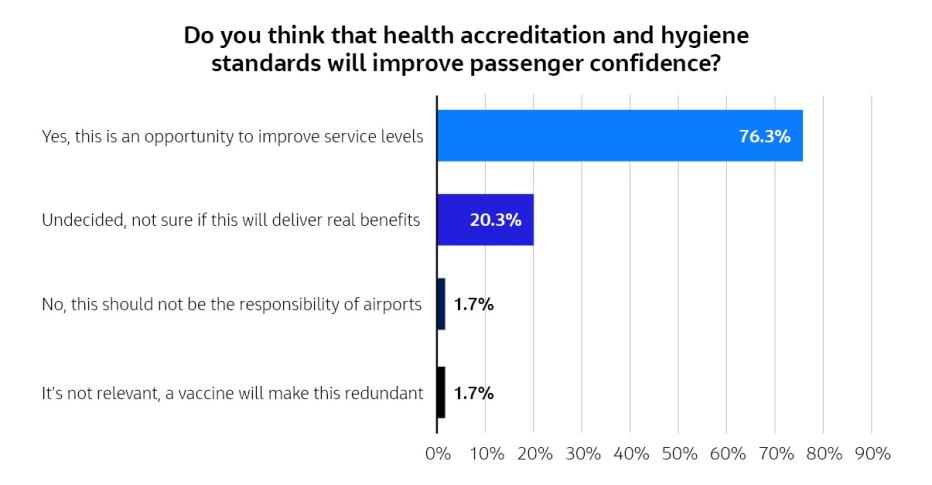
Poll conducted at the AAA National Conference on 4th November 2020
Unsurprisingly, the result reinforces the industry perception that improvements to airport infrastructure, such as health accreditation and hygiene standards will deliver immediate and lasting benefits to both passengers and airports.
Thanks to years of research and development, COVID-19 vaccination is now well underway in some countries. But what about those without the means or access to procure vaccines? And what about its efficacy and effectiveness against new variants that are emerging around the world?
On a global scale, the recovery of air traffic is shifting in different gears. Parts of Asia, India and the U.S. are seeing a strong domestic-led traffic recovery, while others, such as Australia, Singapore and the U.K are hampered by a combination of border closures, hard lockdowns, border control measures or the absence of a domestic market.The uncertainties continue to linger, putting significant strain on airports and airlines alike. Amongst this, is the 14-day quarantine enforcement for arriving passengers from hotspot countries and states. While this has proven to be a relatively safe and reliable approach to help reopen borders, the setbacks to passengers are a major deterrence to travel that will continue to slow traffic recovery.
The broader aviation community has been vocal about what is needed: governments and regulators need to establish a reliable and swift testing system for departures and arrivals. And the good news is, testing regimes have been advancing progressively, providing a far less onerous option for passengers.
In a second poll, we asked:
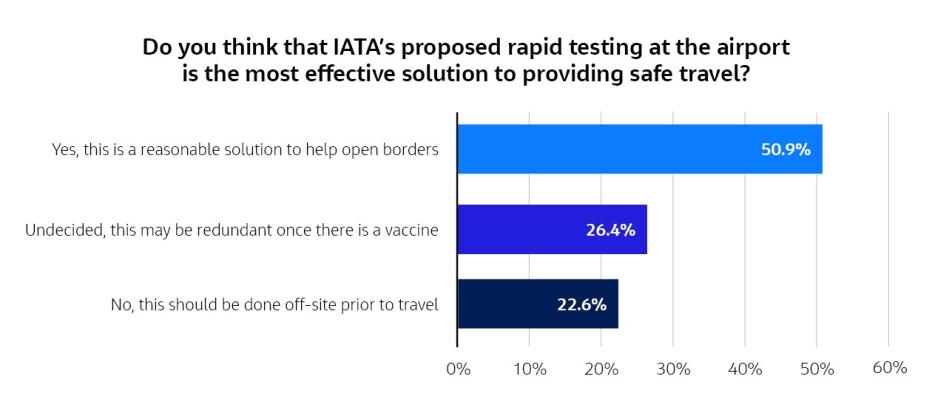
Poll conducted at the AAA National Conference on 4th November 2020
Interestingly, only a slight majority of 50.9 % agreed that COVID-19 testing at airports is the most effective solution to provide safe air travel and reopen borders. 26.4 per cent is less convinced; whereas the remaining 22.6 per cent said it should be done prior to travel. This indicates a strong divide in perceptions on the airport’s role in testing passengers.
In our view, airports should be seeking opportunities to support the creation of safe ‘travel corridors’ for passengers to be exempted from on-arrival quarantine and to travel freely within a zone. Therefore, tests to screen for COVID-19 prior to departure could be required to help reduce risk as governments and policymakers consider relaxing international border- controls.
What can aviation learn from retail?
Travel experiences are amongst the most memorable, yet too often airports are remembered for the unpleasant ones. To this can now be added the heightened sense of anxiousness as airport environments adapt to turbulent times. Understandably, airports are shifting their focus to enhanced passenger health and safety, but we believe customer experience to be more crucial than ever and will endure well beyond the crisis. Perhaps, aviation should look to the broader retail industry for some guidance.
In today’s digital age, the dramatic shift in consumers and brands has evolved away from traditional brick-and-mortar experiences and bolstered online sales platforms. Online or in stores, retailers seek to build personal connections, enhance brand advocacy and step up their game on recruitment spaces to earn more customers. But how does this relate to airports? Airports too, can create memorable experiences by mapping the passenger journey and measuring satisfaction at each touchpoint. Ultimately, we believe it’s about designing inviting spaces that are user-centric, whilst maintaining passenger experience of the highest standards.
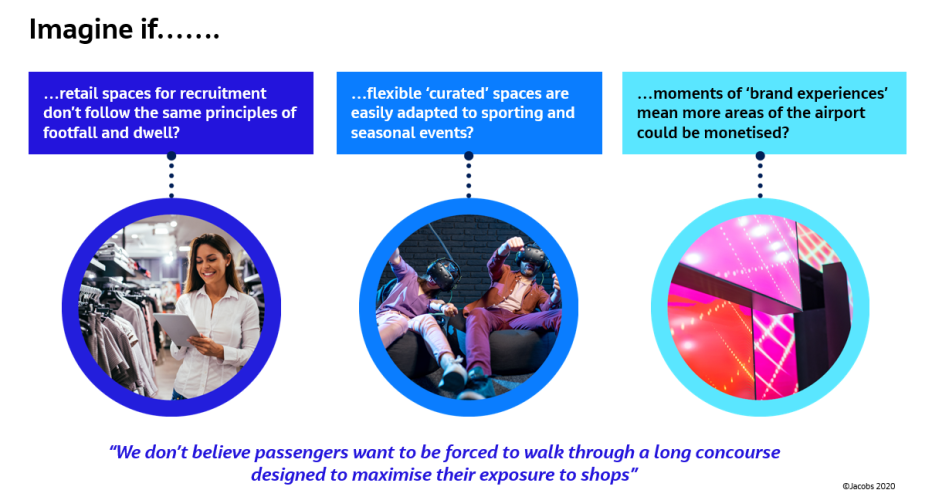
Here are some design interventions to help airports reconfigure and shape recruitment spaces, to enhance the passenger journey and delight customers:
- Breaking down rigid and siloed zoning of retail, food and beverage with clear lines of sight and vistas for people to navigate their way around with ease. This will help curate a more open and flexible passenger journey with opportunities to create moments of surprises.
- Flexibility of commercial spaces. Airports can introduce a flexible grid of 'plug and play open cell' concessions – providing adaptable and conducive spaces to curate sensory experiences that are exclusive to brands for potential collaboration. This concept provides an opportunity for airports to optimize layouts and commercialize more areas of the terminal.
- Experiential retail that combines entertainment activities including virtual and augmented experiences to help forge emotional connections with customers through engaging and personalized experiences.
- Accessibility to social and functional spaces including ‘Work from Home’ airport lounges, providing touchdown workspaces and amenities for health and leisure.
- New sources of revenue that are driven by social networking penetration and shared experiences, rather than traditional sales at the airport till.
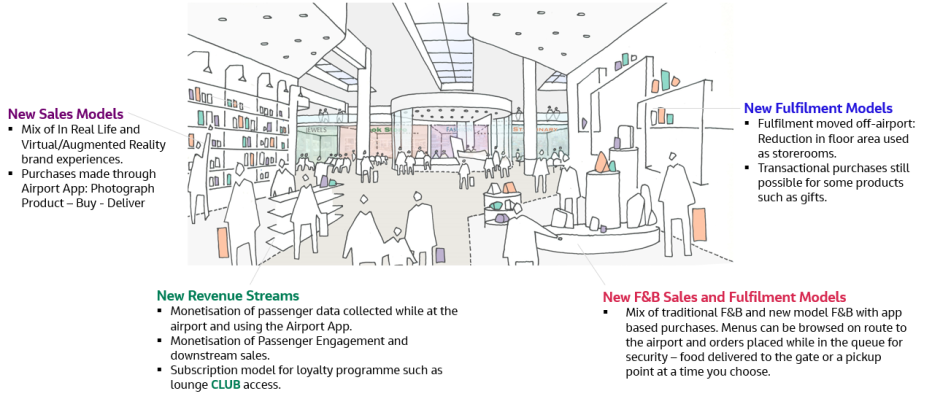
At their best, airports could be destinations unto themselves. Crowned the world’s best airport by Skytrax, Singapore Changi Airport is a leading example. From indoor gardens and waterfall, unique retail and dining experiences, sleeping lounges to world-class attractions, Singapore Changi Airport is truly an unforgettable destination in its own right. The most interesting takeaway for airports, however, is the possibility of broadening revenue streams and return on investments for stakeholders while at the same time, improving passenger journey in the new era of travel.
The long haul threat
While the pandemic is an immediate challenge for the aviation industry, the looming threat of climate change is here for the long haul. How much of a role does aviation play in global emissions and climate change? In 2018, air travel, including freight and military operations accounted for 2.5 per cent of global carbon emissions and 3.5 % of warming. While these are relatively small in comparison to other large-emitting sectors, it has sustained a history of steady growth and the trend is likely to continue.
As part of the presentation, we featured insights by Jacobs Global Solutions Director Transport Planning Stephen Rutherford, who discussed his perspectives on the future of the aviation sector beyond the pandemic, as well as considerations on carbon reduction.

We’re seeing shifting generational attitudes toward climate change. And while it would be some time before the first low-emission aircraft takes off, there are many other ways that aviation can help contribute to decarbonization and mitigate impacts of climate change:
- Building resilience into operational and infrastructure assets.
- Generating sustainable power through micro grids such as solar, wind and geothermal.
- Using Sustainable Aviation Fuels (SAF).
- Creating a travel economy through carbon off-setting.
- Reducing emissions on the ground through electric or hydrogen initiatives.
Another aspect Stephen discussed is providing better surface access to integrate airports with public transport networks for a more connected, reliable and faster journey. This is integral to local emissions around airports and will drive modal shifts in the passenger journey. Accelerating the digitalization for all the touchpoints of the passenger journey will be commonplace across the wider transportation sector, aviation included.
To rebuild passenger trust and confidence, let’s look at initiatives employed by busses and trains:
- Real-time tracking - tracking passenger numbers in near real-time to help manage passenger flow and overcrowding.
- Community-driven contact tracing and checking in to public transport facilities and services.
- Smart bus shelters in which a thermal imaging camera, UV sterilizer, air conditioner, CCTV and digital signage to prevent COVID-19 transmission.
- Touchless kiosks with thermal sensors at busy bus stops and train stations for passengers to check their temperature before boarding.
It is however important to highlight that dynamic information systems are all premised on a robust digital platform. On this point, transportation is undoubtedly ahead of aviation in the implementation of digital technologies. What might the future hold for airports, and how can digital technologies be utilized to improve passenger experience, operational efficiency, safety while generating new and increased revenue?
We explore the topic of digital ecosystem with Jacobs Director of Smart Places Dr. Rick Robinson.

As summarized by Dr. Rick Robinson, digital technology brings people, ideas and places together in new ways. It engages the potential to measure and understand energy consumption, derive efficiencies, incentivize behavior change by sharing resources, collaboration and communicating in new ways.
Let's take a moment to reimagine a future for a departing passenger in a smart terminal:

- Flight information, carpark bookings and dynamic pricing options on passenger journeys to the airport are all linked into a real-time tracking system. Upon arrival, a customized mobile application is automatically activated with a two-swipe function to opt in or out. Those who drive will be greeted with a valet robot that provides quick and convenient self-service system to an intelligent carpark system.
- Gone are the days of physical check-in counters! Baggage will be taken by the valet robot from the terminal or carpark and will be managed by the Baggage Handling System (BHS), likely a decentralized baggage system operated by third party suppliers. Passenger verification is established by on-the-fly via biometric identifiers such as facial recognition, including health checks to verify fitness to fly.
- With advanced technology, smart security screening is now a reality. Security screening is completely walk-through and frictionless, with lanes organized by risk profiling and group type, pre-determined to direct passengers accordingly and manage flow.
- Digital measurement analytics will measure the effectiveness and value of curated spaces. This will enable concessionaires to quantify passenger engagement and determine the need and timing for a refresh.
- Passengers navigate the terminal based on real-time information and avoid areas of potential congestion where possible. Based on their gate and seat allocation, passengers will be notified where to proceed to minimize waiting time.
And just like that, seatbelts fastened; plane takes off. The passenger journey is tailored end-to-end and seamlessly integrated with airport systems.
Parting thoughts
The aviation industry must continuously recalibrate, renew and reinvent themselves in response to both immediate and long-term challenges and the ever-changing demographic, technological, economic and global advancements. Indeed, there are many ways aviation can learn from other sectors to achieve this.
Let’s shift our thinking away from COVID-19 and work towards building resilience for the future. With hopes that COVID-19 will soon be behind us, new technologies and continuous improvements in passenger processing and hygiene standards at airports will offer lasting benefits for the industry as well as build resilience for future events. We believe this is at the heart of aviation’s success and legacy of delivering the highest standards in safety and security.
Throughout my career in aviation, flexibility has always been key. The industry has been tried and tested time and again yet weathered some of the most significant challenges by adopting new ways forward, borrowing from other sectors. With the potential changes to retail and commercial revenue, there will be opportunities to drive higher non-aero revenue streams and accordingly, more cost-effective infrastructure with greater value – which will be more important than ever now, and in the years to come.
About the Author
Joseph Butler is passionate about how technology can deliver a seamless journey for passengers, while improving security, safety and entertainment in a highly regulated environment. He works at the forefront of technological innovations aimed at improving the passenger journey and maximizing airports’ operational efficiency. As the impacts of COVID-19 unfolds, Joseph is developing a specialist service offering to support the recovery of the aviation industry.














































